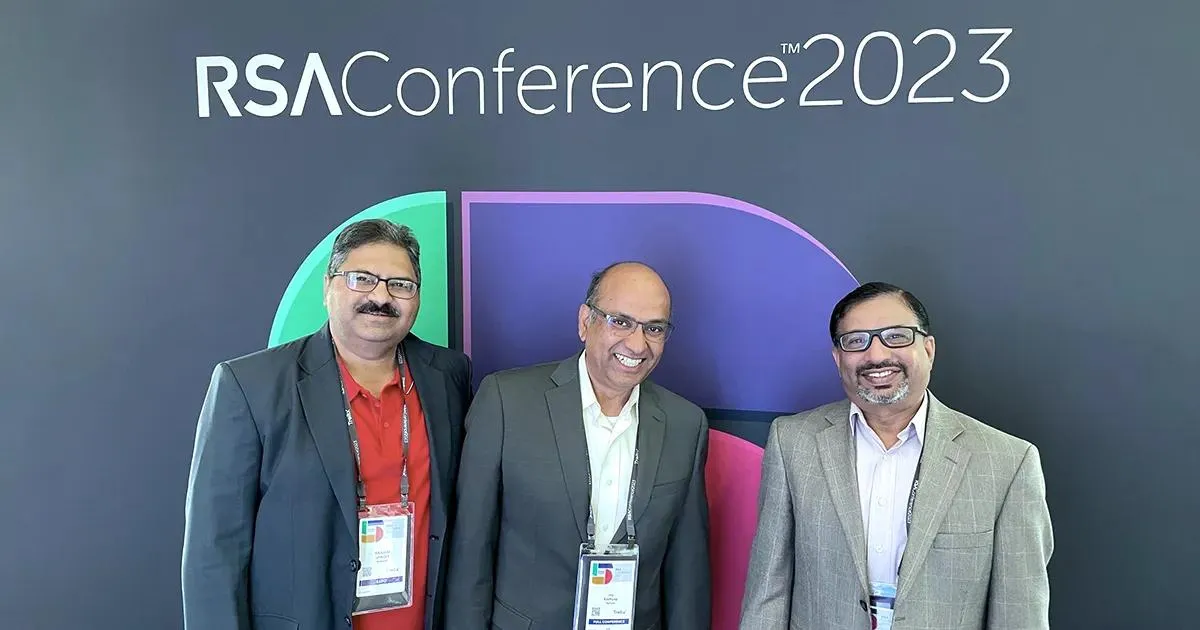



The RSA Conference has played a pivotal role in bringing together the global cybersecurity community. This year’s conference in San Francisco set another precedent in kickstarting crucial conversations by experts, industry leaders, and security professionals on the future of security, its impact on digital transformations, new trends and current challenges, and much more.
As a leading cybersecurity solutions provider, we at Xoriant were pleased to attend the conference. Representing the organization were Jay Kashyap, Deepak Dama, Shankaran Sitarama, and Bankim Shroff.
We bring four key insights from the RSA Conference 2023 that cover the inevitability of security threats, the investment in cybersecurity, the challenges and impact from the security talent shortage and the rise of new vulnerabilities as new technology emerges. Let’s take a look at the insights in detail.
#1 Treating Security Breaches as Inevitabilities
At this year's RSA Conference, industry leaders emphasized the resilience aspect of cybersecurity. Treating them as inevitabilities is key to bracing for impact. Even organizations that have invested heavily in security must acknowledge the possibility of technological failure or unforeseen mishaps.
Start incorporating guardrails into your security program, building in checks and balances throughout your operations. Don't forget to create business continuity and disaster recovery plans, ensuring your organization is ready to weather any storm.
The expo was buzzing with suppliers and start-ups in the cloud security space, reflecting the importance of cloud technologies in contributing to minimizing attack surfaces and exposure to threats.
According to Shankaran Sitarama, VP, Cloud, Infrastructure, and Security Solutions at Xoriant, “Attending the RSA 2023 security conference Expo was a great experience. Zero trust approach was a significant talking point and security breaches being inevitable underlines the importance of zero trust security. Xoriant’s layered security approach has contributed to this by ensuring critical applications and data are embedded deep under layers of security tactics with protection offered at the data, application, endpoint, network, and perimeter levels, contributing to the emergence of zero trust.”
“The event brought together customers, vendors, industry leaders from the security space. It allowed us to gain a deeper understanding of the specialized offerings and witness the impact of our collaborative efforts. These interactions reinforced the value we bring to our customers’ product engineering.”
#2 Investment in Security: A No Brainer
A combination of capricious market conditions, disruptions in the supply chain, inflation, and talent shortages means investments have slowed down and new initiatives are being considered with caution.
According to Sumit Dhawan, President of VMware, "As the cyber threat landscape evolves, our customers require their infrastructure to play a more active role in protecting their enterprise."
VMware announced multiple innovations that ensure deeper protection against cyber breaches in multi-cloud environments and compliance-ready tools. When discussing the financial caveats of security, it is important to remember that the cost of not complying with regulations can be tremendous and should be considered as an aspect of the cost that security programs mitigate.
The gist is that although organizational leaders may see security as a cost-heavy operation, any protection program serves as a shield against incidents. Considering questions like how it can add to the projected revenue? Or how it could empower our reputation, brand, and customers and what does it mean to survive an incident and be back up and running? This help envision a big picture where security costs can be justified and factored into an investment decision.
#3 The Hidden Impact of Security Talent Shortage
Many experts at the conference expressed how advancing cybersecurity solutions demand substantial skills and training requirements. Advanced cybersecurity expertise is a rare commodity, and not all organizations have the means to afford a dedicated Chief Information Security Officer (CISO) or engineering team to oversee the deployment and monitoring of cybersecurity products and patches.
Threat actors know this and use it to target under-resourced partners and suppliers in a target's supply chain to breach well-prepared targets. To bolster security in our interconnected digital world, it's vital for startups to develop accessible and less resource-intensive solutions.
Investors must also support such solutions that enable non-experts, smaller businesses, and everyday users to implement advanced cybersecurity without intimidation. With these efforts, we can help ensure that everyone, regardless of their level of expertise or resources, can take steps to safeguard against cyber threats.
Jay Kashyap, Xoriant CISO, stated, “There was a strong validation for the focus and maturity of Xoriant’s security practice that aligns with the shift left shield right approach. Implementing security in the SDLC right from planning, development and deployment stages creates a robust security posture. Xoriant solutions like Infrastructure as Code, Security as Code, Monitoring as Code, and its expertise in DevSecOps perfectly align with this approach.”
#4 Preparing for New Vulnerabilities that Come with New Technology
An essential aspect of the conference was the spotlight on new technologies like Generative AI and tools like ChatGPT, Google Bard, and many more. Without doubt, AI was the talk of the town at the RSA Conference. Speaker after speaker illustrated the importance of these new technologies and how to adopt them to stay ahead of the curve.
However, many industry experts warned about finding ways to mitigate the vulnerabilities that come with these technologies and called for matching the pace of these technologies with that of developing security controls for them.
The conference also saw buzz for the Zero Trust Strategy, a security model that works on the assumption that all users, devices, and traffic are untrustworthy, making access a privilege and not a right. Rohit Ghai, CEO of RSA, gave a talk on The Looming Identity Crisis which highlighted how identity acts as a shield as well as a primary target for attackers.
Identity and access management tools were a significant talking point, and many speakers illustrated the successful implementation of the Zero Trust approach at their organizations to ensure 360-degree security in the future.
In a Nutshell
In a world of exciting new developments, talking about cybersecurity and its impact on business can be a downer. However, the challenge of innovating new ways and asking the right questions in the quest for a safer digital experience can be just as fascinating.
As an industry, it is up to us to spark these conversations and build new ways to counter security threats. This is why, at Xoriant, we believe in diving head-first into the pursuit of meaningful cyber-resilience.
If you are looking for a knowledgeable and experienced technology partner who can improve your organization’s security stature, Xoriant can be the game changer. Our Cloud Infrastructure and Security experts have been helping global customers for over three decades and can secure your business using our rich and extensive experience.
Fortify your organization with innovative security strategies and best practices






 View Previous Blog
View Previous Blog






